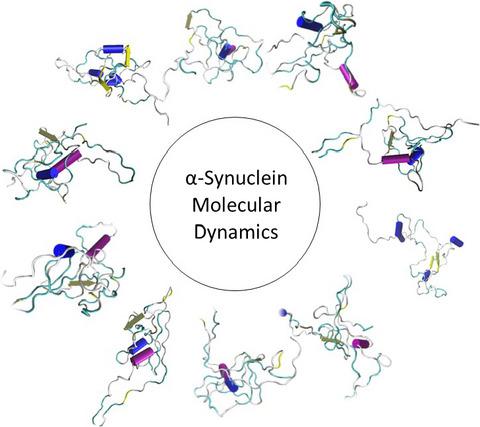当前位置:
X-MOL 学术
›
Chem. Bio. Drug Des.
›
论文详情
Our official English website, www.x-mol.net, welcomes your
feedback! (Note: you will need to create a separate account there.)
Epitope region identification challenges of intrinsically disordered proteins in neurodegenerative diseases: Secondary structure dependence of α-synuclein on simulation techniques and force field parameters.
Chemical Biology & Drug Design ( IF 3.2 ) Pub Date : 2020-01-06 , DOI: 10.1111/cbdd.13662 Sunay Y Mandaci 1 , Murat Caliskan 1 , M Furkan Sariaslan 1 , Vladimir N Uversky 2, 3 , Orkid Coskuner-Weber 1
Chemical Biology & Drug Design ( IF 3.2 ) Pub Date : 2020-01-06 , DOI: 10.1111/cbdd.13662 Sunay Y Mandaci 1 , Murat Caliskan 1 , M Furkan Sariaslan 1 , Vladimir N Uversky 2, 3 , Orkid Coskuner-Weber 1
Affiliation

|
Due to fast aggregation processes of many disordered proteins in neurodegenerative diseases, it is difficult to study their epitope regions at the monomeric and oligomeric levels. Computer simulations complement experiments and have been used to identify the epitope regions of proteins. Residues that adopt β‐sheet conformation play a central role in the oligomerization and aggregation mechanisms of such proteins, including α‐synuclein, which is at the center of Parkinson's and Alzheimer's diseases. In this study, we simulated the monomeric α‐synuclein protein in an aqueous environment to evaluate its secondary structure properties, including β‐sheet propensity, and radius of gyration by replica exchange molecular dynamics simulations. We also obtained the molecular dynamics simulation trajectories of α‐synuclein that were conducted using various force field parameters by the David E. Shaw group. Using these trajectories, we calculated the impacts of force field parameters on α‐synuclein secondary structure properties and radius of gyration values and obtained results are compared with our data from REMD simulations. This study shows that the chosen force field parameters and computer simulation techniques effect the predicted secondary structure properties and radius of gyration values of α‐synuclein in water. Herewith, we illustrate the challenges in epitope region identification of intrinsically disordered proteins in neurodegenerative diseases by current computer simulations.
中文翻译:

神经退行性疾病中固有紊乱蛋白的表位区域识别挑战:α-突触核蛋白对模拟技术和力场参数的二级结构依赖性。
由于神经退行性疾病中许多无序蛋白的快速聚集过程,因此难以在单体和寡聚水平上研究其表位区域。计算机模拟补充了实验,并已用于鉴定蛋白质的表位区域。采用β-折叠构象的残基在此类蛋白质的寡聚和聚集机制中起着核心作用,其中包括位于帕金森氏病和阿尔茨海默氏病中心的α-突触核蛋白。在这项研究中,我们通过复制交换分子动力学模拟在水性环境中模拟了单体α-突触核蛋白,以评估其二级结构特性,包括β-片层倾向和回转半径。我们还获得了David E.Shaw组使用各种力场参数进行的α-突触核蛋白的分子动力学模拟轨迹。使用这些轨迹,我们计算了力场参数对α-突触核蛋白二级结构特性和回转半径的影响,并将所得结果与我们来自REMD仿真的数据进行了比较。这项研究表明,所选的力场参数和计算机模拟技术会影响水中α-突触核蛋白的预测二级结构性质和回转半径。因此,我们通过当前的计算机模拟说明了神经退行性疾病中内在无序蛋白的表位区域识别中的挑战。我们计算了力场参数对α-突触核蛋白二级结构特性和回转半径的影响,并将所得结果与我们通过REMD模拟得到的数据进行了比较。这项研究表明,所选的力场参数和计算机模拟技术会影响水中α-突触核蛋白的预测二级结构性质和回转半径。因此,我们通过当前的计算机模拟说明了神经退行性疾病中内在无序蛋白的表位区域识别中的挑战。我们计算了力场参数对α-突触核蛋白二级结构特性和回转半径的影响,并将所得结果与我们通过REMD模拟得到的数据进行了比较。这项研究表明,所选的力场参数和计算机模拟技术会影响水中α-突触核蛋白的预测二级结构性质和回转半径。因此,我们通过当前的计算机模拟说明了神经退行性疾病中内在无序蛋白的表位区域识别中的挑战。这项研究表明,所选的力场参数和计算机模拟技术会影响水中α-突触核蛋白的预测二级结构性质和回转半径。因此,我们通过当前的计算机模拟说明了神经退行性疾病中内在无序蛋白的表位区域识别中的挑战。这项研究表明,所选的力场参数和计算机模拟技术会影响水中α-突触核蛋白的预测二级结构性质和回转半径。因此,我们通过当前的计算机模拟说明了神经退行性疾病中内在无序蛋白的表位区域识别中的挑战。
更新日期:2020-01-06
中文翻译:

神经退行性疾病中固有紊乱蛋白的表位区域识别挑战:α-突触核蛋白对模拟技术和力场参数的二级结构依赖性。
由于神经退行性疾病中许多无序蛋白的快速聚集过程,因此难以在单体和寡聚水平上研究其表位区域。计算机模拟补充了实验,并已用于鉴定蛋白质的表位区域。采用β-折叠构象的残基在此类蛋白质的寡聚和聚集机制中起着核心作用,其中包括位于帕金森氏病和阿尔茨海默氏病中心的α-突触核蛋白。在这项研究中,我们通过复制交换分子动力学模拟在水性环境中模拟了单体α-突触核蛋白,以评估其二级结构特性,包括β-片层倾向和回转半径。我们还获得了David E.Shaw组使用各种力场参数进行的α-突触核蛋白的分子动力学模拟轨迹。使用这些轨迹,我们计算了力场参数对α-突触核蛋白二级结构特性和回转半径的影响,并将所得结果与我们来自REMD仿真的数据进行了比较。这项研究表明,所选的力场参数和计算机模拟技术会影响水中α-突触核蛋白的预测二级结构性质和回转半径。因此,我们通过当前的计算机模拟说明了神经退行性疾病中内在无序蛋白的表位区域识别中的挑战。我们计算了力场参数对α-突触核蛋白二级结构特性和回转半径的影响,并将所得结果与我们通过REMD模拟得到的数据进行了比较。这项研究表明,所选的力场参数和计算机模拟技术会影响水中α-突触核蛋白的预测二级结构性质和回转半径。因此,我们通过当前的计算机模拟说明了神经退行性疾病中内在无序蛋白的表位区域识别中的挑战。我们计算了力场参数对α-突触核蛋白二级结构特性和回转半径的影响,并将所得结果与我们通过REMD模拟得到的数据进行了比较。这项研究表明,所选的力场参数和计算机模拟技术会影响水中α-突触核蛋白的预测二级结构性质和回转半径。因此,我们通过当前的计算机模拟说明了神经退行性疾病中内在无序蛋白的表位区域识别中的挑战。这项研究表明,所选的力场参数和计算机模拟技术会影响水中α-突触核蛋白的预测二级结构性质和回转半径。因此,我们通过当前的计算机模拟说明了神经退行性疾病中内在无序蛋白的表位区域识别中的挑战。这项研究表明,所选的力场参数和计算机模拟技术会影响水中α-突触核蛋白的预测二级结构性质和回转半径。因此,我们通过当前的计算机模拟说明了神经退行性疾病中内在无序蛋白的表位区域识别中的挑战。











































 京公网安备 11010802027423号
京公网安备 11010802027423号